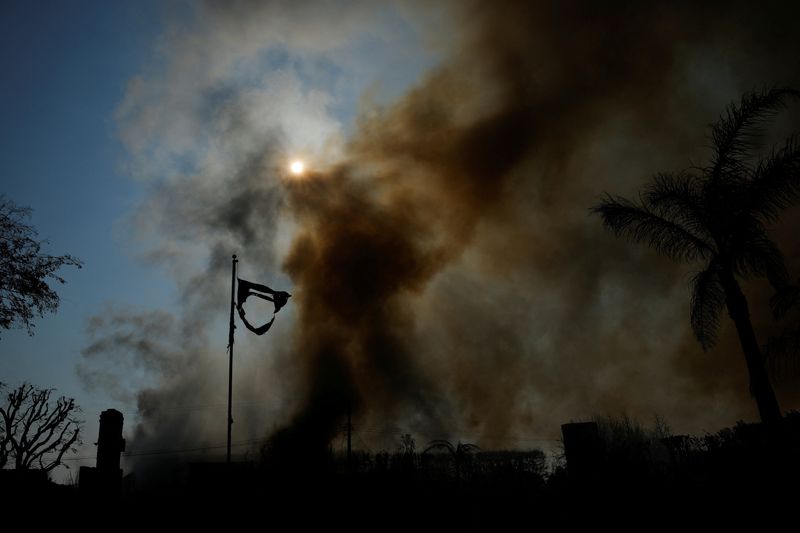Explainer-What are the health risks from wildfire smoke? By Reuters

Written by Nancy Lapid
(Reuters) – Massive wildfires are raging in Los Angeles, shrouding the surrounding areas in an acrid haze caused by smoke that carries harmful gases and particulates that pose serious health risks.
Here’s what you need to know about the dangers of smoke that’s likely to linger not just in Southern California but in other areas around the world where wildfires are burning:
What does wildfire smoke contain?
More toxic than regular air pollution, wildfire smoke can remain in the air for weeks and travel hundreds of miles.
Forest fires can not only burn plant material and trees, but also burn cities, destroying vehicles, buildings and their contents. Besides soil particles and biological materials, wildfire smoke often contains traces of chemicals, metals, plastics and other synthetic materials.
What are the known health effects?
In laboratory experiments, a given amount of wildfire smoke causes more inflammation and tissue damage than the same amount of air pollution, according to Kent Pinkerton, associate director of the Center for Health and Environment at the University of California, Davis.
Studies have linked wildfire smoke to higher rates of heart attacks, strokes, and cardiac arrests, increased emergency room visits for respiratory illnesses, and weakened immune defenses. A study in Maryland identified a spike in heart and lung disease in 2023, which was linked to wildfire smoke originating up to 2,100 miles (3,380 km) away in Canada.
Wildfires have also been linked to eye irritation and skin problems.
The effects of exposure can last for years. After the 2014 Hazelwood coal mine fire in Australia, rates of heart disease remained high for two and a half years, and respiratory disease for five years, researchers reported.
Exposure to wildfires during pregnancy has been associated with pregnancy loss, low birth weight, and premature birth. A study from California found a link between exposure to wildfires and cell damage in the placenta in the first and second trimester of pregnancy.
Canadian researchers reported that people who lived outside major cities and within 50 kilometers (31 miles) of wildfires in the past decade had a 4.9% higher risk of lung cancer and a 10% higher risk of brain tumors.
Exposure to the 2018 Camp Fire in California was associated with changes in cognition and brain activity six to 12 months later, possibly related to stress and trauma, according to California researchers.
Data from California also show an increase in fungal infections in the months following exposure to wildfire smoke, likely due to the presence of fungal spores in the smoke.
Higher exposure to wildfire smoke is also linked to a higher risk of developing dementia, according to a study of older adults in Southern California who did not have dementia at baseline. Even “several days of intense wildfire smoke,” with the AQI exceeding 200, can translate into increased risks, said Joan Casey of the University of Washington in Seattle, who led the study.
What is not known?
More frequent wildfires are likely linked to climate change, meaning people will be exposed to them more often, and the health effects of exposure to wildfire smoke over several seasons are not yet clear.
“Repeated exposure is likely to cause illness, but it is difficult to make predictions because it is difficult to determine how many fires people will be exposed to, how long the fires will last, or what the smoke will contain,” Keith Bean said. Center for Health and Environment at UC Davis.
Researchers are also looking at the long-term effects of smoke particles found in water supplies, on crops, or ingested by livestock; the long-term effects of urban wildfire smoke; Effects of exposure to wildfires in utero on children’s neurodevelopment and respiratory outcomes; And whether wildfire smoke amplifies the harmful effects of extremely hot weather.
Researchers warn that nutrients carried by wildfire smoke may contribute to downwind algae blooms, with implications for drinking water reservoirs and the lake environment.
What can help mitigate risks?
Experts say it is best to limit outdoor activities, especially strenuous sports, and wear N95 masks when wildfire smoke is present.
An online course with instructions for reducing outdoor and indoor exposure to wildfire smoke is available from the U.S. Environmental Protection Agency.

Do we really need to worry?
Wildfire smoke can be deadly, said Doug Brugge, who chairs the Department of Public Health Sciences at the UCLA School of Medicine. “People should… reduce their exposure, especially if they are in vulnerable populations, such as the elderly, young children or people with respiratory illnesses.”
https://i-invdn-com.investing.com/news/news_pile_69x52._800x533_L_1419494209.jpg
2025-01-09 22:26:00





